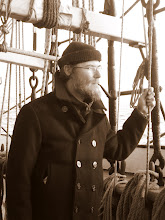Domestic Tranquility Systems
This is the first post in the "Crew Stream" series I mentioned in Part 5b.
A globe trotting airship like ours is more than just an engine hanging
from a balloon! The officers, crew and passengers need to be able to
live aboard for extended periods of time. What's more some of the crew
members are Ladies so we must include many creature comforts for them.
As a reminder here is the general layout of the crew spaces:
- As is typical of the big rigid airships, heavier loads are placed along the bottom of the hull either inside it along the keel or in extensions that extend beneath.
- From forward we have the crew accommodations (officers and passengers) and the flight deck, from which the airship is controlled. Proceeding aft of this is the forward cargo hold (and armory when on military service), above this is the remaining crew accommodations, next aft is the engine room, the reactor/steam generator with its large water tank, the aft cargo hold, and finally an emergency steering and control position inside the lower fin.
- These spaces are connected by a narrow triangular "keel walk" similar to that found in the Hindenburg.
My buddy Grant has created a layout for the forward accommodations which I present here slightly modified:
This layout is based on the control car of the Graf Zeppelin and I think it works quite well for us.
In the airship which we are role playing aboard, the space marked "secure cargo hold" is in fact a fancy bath room with a large tub and elegant furnishings for the use of the ladies. It is known by popular consent as the "Bubble Bath Room"
The triangular keel walk runs above the accommodations along the line of the central passage shown. This keel walk can be reached by ladders from the passage way. Here is a picture of the keel walk of the Hindenburg to give you an idea of what it would look like.
At the forward end of the keel walk, right above the Flight Deck is the Captain's cabin. There is a private ladder that leads down to the Flight Deck for his personal use.
These accommodations are for the use of the officers and those guests which are traveling aboard. The crew have their accommodations along either side of the keel walk where it passes over the forward cargo hold. Their space is nowhere near as fancy as the officers quarters forward, although it is likely much better than what their brothers at sea wold have put up with.
As was typical for surface naval ships of the Victorian period the engine room personnel had separate accommodations to that of the rest of the crew. We follow that same pattern with the "black gang" having their berths also along either side of the keel walk but over the after cargo hold.
The Officers cabins, the Wardroom, the passengers cabins all are decorated with elegant dark wood furniture, bright wallpapers and heavy looking bunks. It may seem odd that there would be fancy and heavy looking furniture and decorations in the cabins of an airship, but one must remember that in Victorian times such things existed in some very surprising places. I have been into some preserved Victorian farmhouses out on the Canadian prairies that had elegant wallpaper, heavy oak tables and chairs. All of which had been shipped first by train then by wagon to these remote farmsteads. They were sources of great pride for their owners.
Likewise on our experimental airship such things are the pride of the crew. While they look like they are as heavy as their land and sea based compatriots these are very light. They are constructed of very light materials like pine and balsa wood, with a veneer of the dark oak and rosewood that was so popular. Even the books in the library are made of the thin bible paper called onion skin.
Join me next time as I continue the discussion of the creature comforts of our airship.
Keep your sightglass full, your firebox trimmed and your water iced.
KJ
The next article is here.
You can follow the full design thread by clicking on the tag "Flight Engineer".





~ 0 comments: ~
~ Post a Comment ~